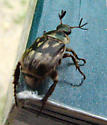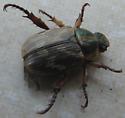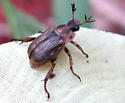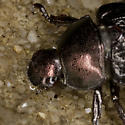Synonyms and other taxonomic changes
Phyllopertha orientalis Waterhouse 1875:108
Blitopertha orientalis (Waterhouse), authors
Exomala orientalis (Waterhouse), Baraud 1991, Piattella and Sabatinelli 1994
Identification
Elytra each with 6 deeply grooved striae between humeral umbone (swollen area - striae don't continue over top of swelling) and suture (midline); intervals (area between striae) subequal (almost equal), subsutural (adjacent to suture) interval not much broader or multipunctate; variously marked but often with dark fasciate spots or bands - rarely all black. Pronotum immaculate to black, with or without paired maculae (darkened region).
Range
Introduced from Asia. Asia, Hawaii, eastern coast of the United States from Maine to South Carolina and Wisconsin.
Habitat
larvae are found in the soil under lawns
adults are occasionally found on flowers such as rose and hollyhock blossoms
Season
adults emerge in late June and July
Food
larvae feed on grass roots just beneath the surface of the ground
adults feed very little
Life Cycle
In mid-summer, eggs are laid in the soil, up to a depth of about 6 inches. These eggs hatch 3 to 4 weeks later and the young grubs ascend and feed on the grass roots near the surface. In late October and November, they descend 12 inches to overwinter. In April, they resurface and resume feeding until the first of June when they go down to a depth of about 6 inches to pupate. They pass through a prepupal period of about 6 days, then pupate, and 2 weeks later the adults emerge. There is one generation each year, although a few individuals do not transform with the others, therefore requiring 2 years for their development. [from Govt. of Connecticut site; see below]
Remarks
Often considered Exomala sp.
Internet References
live adult image [near bottom of page] plus description and biology (Connecticut Agricultural Experiment Station, Govt. of Connecticut)
pinned adult images plus common name reference [Oriental Beetle], description, damage, and control (U. of Minnesota)
common name reference; PDF doc [Asiatic Beetle] (Turfgrass Information File, Michigan State U.)









